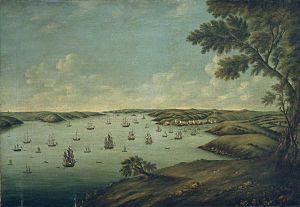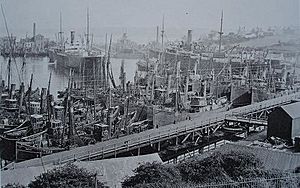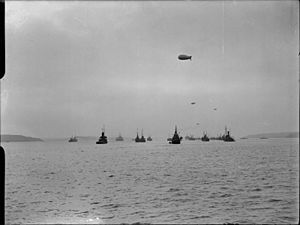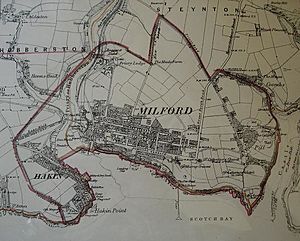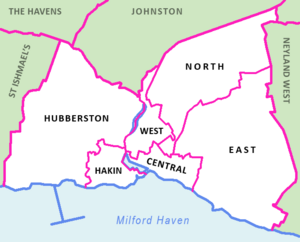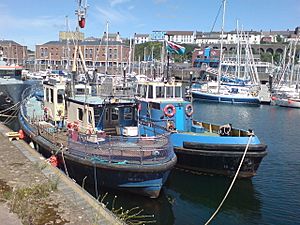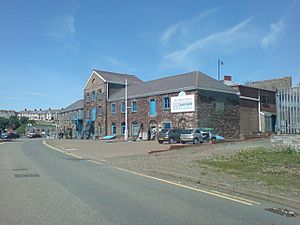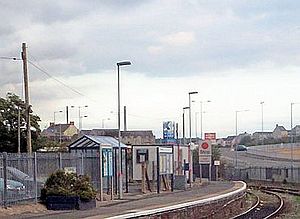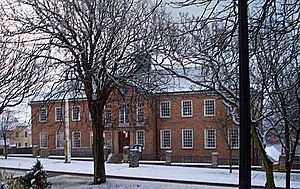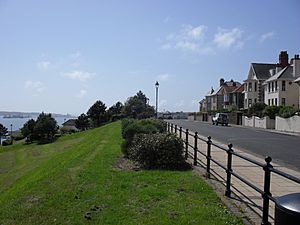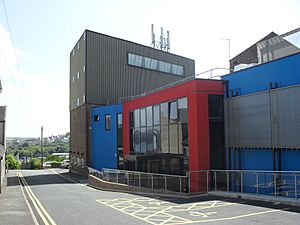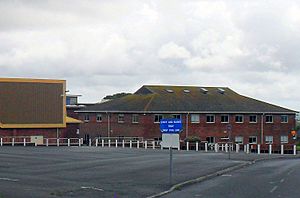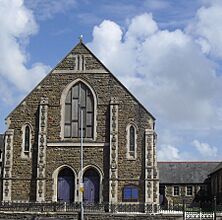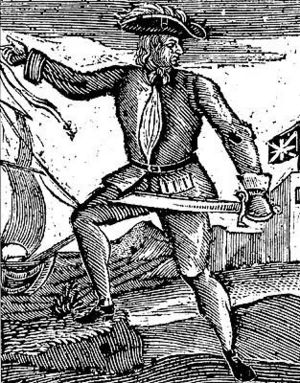Milford Haven facts for kids
Quick facts for kids Milford Haven
|
|
|---|---|
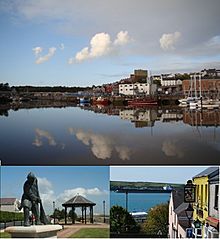 Clockwise from top: Milford Haven Docks from Hakin; Haven from town; the Tribute to Fishermen on The Rath. |
|
| Population | 13,907 (Community 2011) |
| Demonym | Milfordian |
| OS grid reference | SM899061 |
| Community |
|
| Principal area | |
| Ceremonial county | |
| Country | Wales |
| Sovereign state | United Kingdom |
| Post town | MILFORD HAVEN |
| Postcode district | SA73 |
| Dialling code | 01646 |
| Police | Dyfed-Powys |
| Fire | Mid and West Wales |
| Ambulance | Welsh |
| EU Parliament | Wales |
| UK Parliament |
|
| Welsh Assembly |
|
Milford Haven is a town and community in Pembrokeshire, Wales. It sits on the north side of the Milford Haven Waterway. This waterway is a natural harbour that has been used as a port since the Middle Ages.
The town was started in 1790 by Sir William Hamilton. He planned it with a grid street pattern. At first, he wanted it to be a whaling center. By 1800, it became a Royal Navy dockyard, where warships were built. The dockyard moved to Pembroke in 1814. After that, Milford Haven became a commercial port. In the 1960s, after an oil refinery was built by Esso, it became a major hub for fuel oil and liquid gas. By 2010, Milford Haven's port was the fourth largest in the UK for the amount of goods it handled. It is still very important for the UK's energy supply, with several oil refineries and one of the world's biggest LNG (Liquefied Natural Gas) terminals.
Milford Haven is the most populated community in Pembrokeshire. In 2011, about 13,907 people lived there. The natural harbour has been a safe place for ships for a very long time. It was used for military operations, like Henry II's invasion of Ireland in 1171 and Cromwell's invasion in 1649. In 1485, Henry VII landed near his birthplace before marching to England.
Contents
- Milford Haven's Past
- Milford Haven's Location and Weather
- How Milford Haven is Governed
- Milford Haven's Economy
- Getting Around Milford Haven
- Milford Haven's Population
- Milford Haven's Buildings
- Famous Places in Milford Haven
- Milford Haven's Culture and Community
- Sports and Fun in Milford Haven
- Learning in Milford Haven
- Places of Worship in Milford Haven
- Famous People from Milford Haven
- See also
Milford Haven's Past
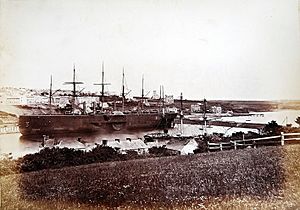
The town of Milford was founded in 1793. Sir William Hamilton got permission in 1790 to build a port there. The town gets its name from the Milford Haven Waterway, a natural harbour used for centuries. Vikings used it as a shelter. It was known as a safe port and is even mentioned in Shakespeare's play Cymbeline.
The harbour was a base for many military actions. These included Richard de Clare's invasion of Leinster in 1167 and Henry II's invasion of Ireland in 1171. Oliver Cromwell also used it for his invasion of Ireland in 1649.
Sir William Hamilton, who founded the town, got the land from his wife. His nephew, Charles Francis Greville, invited seven Quaker families from America to settle there. They were meant to start a whaling fleet. They first built a shipyard. In 1800, the Navy Board took over the shipyard to build warships. Seven royal ships were launched from there. The town was built with a grid pattern, possibly designed by Jean-Louis Barrallier, who managed the shipbuilding.
In 1814, the Royal Dockyard moved to Pembroke Dock. However, a commercial dock started in Milford Haven, which became a successful fishing port. By 1849, Hakin was known for boat building. By 1906, Milford was the sixth largest fishing port in the UK, and its population grew. The Pembrokeshire Herald newspaper said in 1912 that "the fish trade is Milford's sole industry."
The railway arrived in Milford in 1863, connecting it to Haverfordwest. Between 1875 and 1886, the large ship Great Eastern was often in Milford Docks for repairs. Her presence showed that the town could handle very big ships.
In the late 1850s, forts were built around the Milford Haven estuary. These were to defend the UK from a possible French invasion. Examples in the town include Fort Hubberstone and Scoveston Fort.
By 1901, the town's population was 5,102. By 1931, it had doubled to 10,104. In the First World War, the Haven was a meeting point for convoys going to Gibraltar. It was also a base to fight German U-boats. Many council houses were built between the World Wars, and public services like electricity were added.
In the Second World War, Milford Haven became a base for American troops. About 1,000 American soldiers were stationed there. They ran a base with a hospital and docks. This base helped prepare for D-Day. Even though it was important, Milford Haven was not badly damaged by German bombs.
In 1960, the Esso Company opened an oil refinery near the town. Other oil companies like Texaco and BP also built facilities. By 1974, Milford handled 58.5 million tons of oil, three times more than all other Welsh ports combined. In 1996, the oil tanker Sea Empress ran aground, causing a large oil spill.
What's in a Name?
Milford Haven's name comes from an old Scandinavian name "Melrfjordr." Melr means sandbank, and fjordr means inlet. This became "Milford." Later, "Haven" was added, meaning port or harbour. The Welsh name, "Aberdaugleddau," means "mouth of the two rivers Cleddau." These are the White River Cleddau and the Black River Cleddau.
Milford Haven's Location and Weather
Milford Haven is on the north bank of the Milford Haven Waterway. This waterway is a "ria," which means a river valley that has been flooded by the sea. The area has low, wooded shorelines, creeks, and mudflats.
The town has an old center from the late 1700s and 1800s, with a grid street pattern. Milford Haven has grown to include older settlements like Hakin and Hubberston to the west. Steynton, a medieval village, is now part of the expanded town.
Milford Haven has mild weather. Being near the coast means wet winters, but it gets more sunshine than most of the UK. It has about 1,600 hours of sunshine each year.
How Milford Haven is Governed
Local and National Government
Milford Haven is part of the Preseli Pembrokeshire area for both the Welsh Parliament (Senedd) and the UK Parliament. The local Member of the Senedd is Paul Davies from the Conservative Party. The local Member of Parliament is Henry Tufnell from the Labour Party.
When the town started in the 1790s, it was part of the parishes of Steynton and Hubberston. In 1894, Milford Haven became an urban district with its own elected council. This council built the Milford Haven Town Hall in 1939. In 1974, the urban district was changed, and a new community council, called Milford Haven Town Council, was formed.
Milford Haven's Economy
Milford Haven has had times of great success and times of difficulty. This has happened in shipbuilding, fishing, and as a port. When fishing was at its best, people said "every day was a pay day." In 1921, 674 people worked in fishing, making it the town's main job. At its busiest, over 200 trawlers and 2,000 people worked in the fishing industry.
The oil industry also helped the town's economy. However, there have been tough times too. Over-fishing and national economic problems led to a big drop in the fishing industry. By 1972, only twelve trawlers were registered at the port.
In the 1980s and 1990s, unemployment sometimes reached over 30%. The oil refining industry, while important, did not create many direct jobs for locals. In the new millennium, things have improved, especially with the LNG terminal.
International tourism has also grown. Large cruise ships now visit Milford Haven, bringing money to the town. In 2012, 3,000 cruise passengers visited. The waterway transports 25% of Britain's motor fuel. In 2008, the port handled 53 million tons of shipping, making it the largest port in Wales.
There are two main shopping areas: Charles Street in the old town center, and the Havens Head Retail Park near the docks. In 2012, the Milford waterway was named an "Enterprise Zone" by the government. This was because of its importance to the energy sector. Plans were announced in 2014 to change the docks area into a place with homes, shops, and hotels.
| Year | 1890 | 1900 | 1910 | 1920 | 1939 | 1946 | 1950 | 1960 | 1970 | 1980 | 1990 | 2000 | 2010 | 2017 |
|---|---|---|---|---|---|---|---|---|---|---|---|---|---|---|
| Catch (tonnes) | 9,500 | 22,500 | 38,000 | 46,000 | 43,000 | 59,000 | 35,000 | 12,000 | 4,000 | 2,000 | 2,500 | 3,450 | 2,900 | 3,000 |
| Fleet | 12 | 65 | 64 | 62 | 109 | n/a | 97 | 27 | n/a | 5 | 7 | n/a | n/a | 2 |
| Fishermen | n/a | 520 | n/a | n/a | 1,200 | n/a | 1,000 | 271 | n/a | 35 | 88 | n/a | n/a | n/a |
Visiting Milford Haven
After the Second World War, Milford Haven was not seen as a good place for tourists. There were not many beaches nearby, and there was a lot of industry. However, in the 1980s, efforts began to make parts of the town more beautiful. An old outdoor swimming pool was turned into a water-garden in 1990.
In 1991, the Tall Ships Race started from Milford. This led to big changes at the docks. It was renamed a marina, and new cafes, restaurants, and shops opened. There is a tourist information center and a local museum. The museum, in the old Custom House, tells the story of the area's sea history.
Getting Around Milford Haven
The first railway reached Milford Haven in 1863. The trains were run by Great Western Railway.
Milford Haven railway station is the end of the West Wales Line. Trains are operated by Transport for Wales Rail. Trains leave every two hours to Manchester Piccadilly, stopping at places like Carmarthen and Cardiff Central.
The main road in and out of Milford Haven is the A4076. This road connects to Pembroke Dock and Haverfordwest. To get to Hakin and the western part of town, you cross Victoria Bridge over the docks.
Buses run through the town, with services to Haverfordwest and Pembroke Dock. National Express also has services to major cities like London.
Milford Haven's Population
| Population growth in Milford Haven since 1841 | |||||||||||||||||
|---|---|---|---|---|---|---|---|---|---|---|---|---|---|---|---|---|---|
| Year | 1841 | 1851 | 1861 | 1871 | 1881 | 1891 | 1901 | 1911 | 1921 | 1931 | 1951 | 1961 | 1971 | 2001 | 2011 | 2021 | |
| Population | 2,377 | 2,837 | 3,007 | 2,836 | 3,812 | 4,070 | 5,102 | 6,399 | 7,772 | 10,104 | 11,710 | 12,802 | 13,760 | 13,096 | 13,907 | 14,798 | |
| Source: Vision of Britain & Field Studies Journal | |||||||||||||||||
By the 1950s, the fishing industry was declining, and unemployment was high. However, many new homes were built after the Second World War. The District Council built over 1,000 new houses for the growing population. The oil industry brought new hope, but it did not create many jobs for local people.
Milford Haven is not very diverse. In 2011, 96.4% of people identified as white. Most residents (92.9%) were born in the UK. English is the first language for 96.3% of residents.
Welsh Language in Milford Haven
Milford Haven is in an area known as "Little England Beyond Wales." English has been the main language here for centuries. Only a small number of people in Milford Haven speak Welsh. In 2011, only 7.5% of residents could speak, read, and write Welsh. This is much lower than the average for Pembrokeshire (18%) and Carmarthenshire (40%).
Milford Haven's Buildings
Most buildings in Milford Haven were built after the town was founded in 1790. A few older buildings exist, like the medieval priory and a 12th-century chapel.
The first buildings from the late 1700s are in the town center. These are three parallel streets: Hamilton Terrace, Charles Street, and Robert Street. They have three-story Georgian style homes and shops.
Later, in the late 1800s, rows of terrace houses were built for the growing population. These spread north and east. Newer, detached and semi-detached homes were built overlooking the waterway. In the early 1900s, many council houses were built on former farmland. These large housing estates changed rural areas into urban ones.
Famous Places in Milford Haven
One famous place is Fort Hubberstone. It was built in 1863 to defend the Haven from attacks. It is in Gelliswick bay, west of the town, and overlooks the waterway. The fort is not open to the public. In 2011, it was called one of the most endangered archaeological sites in the UK.
The ruins of an observatory are in Hakin. It was meant to be part of "The College of King George the Third." Building stopped in 1809. The Milford Haven Museum is in the docks area. It is in the town's oldest building, the Custom House, built in 1797. It was used to store whale oil.
The Rath is a landscaped street on high ground with great views of the Haven. In the 1700s, it was a gun battery. In the 1930s, it had an outdoor swimming pool, which became a water garden in 1990. The Milford Haven Waterway is a large natural harbour.
Milford Haven's Culture and Community
The Torch Theatre opened in 1977. It is one of only three repertory theaters in Wales and has its own theater company. The Pill Social Centre is a community hall that has hosted famous bands like The Who.
Annual events include the Milford Haven Music Festival in May, Founders Week in June, and the carnival in July. Pembrokeshire Fish Week happens every two years in June. Milford Haven library is at Havens Head Retail Park and offers books and internet access. The Milford Haven Museum focuses on the town's sea history.
The Milford & West Wales Mercury was a weekly newspaper covering the area. Milford Haven is twinned with Romilly-sur-Seine, France, and Uman, Ukraine.
Milford Haven in Books, Films, and TV
Milford Haven appears in many stories. Shakespeare's play Cymbeline calls it "blessed Milford." It is also where King Arthur landed from Ireland in the Welsh story Culhwch and Olwen.
The town was used as a filming location for the BBC show The Onedin Line. It was also used for the 1968 film The Lion in Winter. More recently, locations like Hakin Point were used for filming The Pembrokeshire Murders in 2020.
Sports and Fun in Milford Haven
Milford Haven has many places for sports and fun. Milford Haven Leisure Centre has a 25-meter indoor swimming pool, squash and tennis courts, and a dance studio. Thornton Hall at Milford Haven School has an indoor sports hall.
There are rugby union and association football (soccer) clubs. Water activities are based around the marina and Pembrokeshire Yacht Club. There is also a golf club on the edge of town, started in 1913.
Milford Marina, once working docks, was updated in 1991. It now has shops, the town museum, and entertainment. The marina has 360 places for private boats.
Learning in Milford Haven
For younger children, Milford Haven has six state primary schools and one Roman Catholic primary school. Hakin pupils can go to Hakin Community School.
Older students attend Milford Haven School, a large comprehensive school with about 1200 students, including a 6th form (ages 16-18).
The MITEC School of Boatbuilding & Marine Engineering, part of Pembrokeshire College, offers courses in building boats and marine engineering.
Places of Worship in Milford Haven
In the 2011 census, 60.5% of Milford Haven residents identified as Christian. The oldest known religious building was the Benedictine priory, Pill Priory, which was closed in Henry VIII's time. Another early building was the Catholic St. Thomas à Becket chapel, built around the 12th century.
The first church built after Milford Haven was founded was the Church in Wales church of St. Katharine and St. Peter. It is considered the town's main church. Other Church in Wales buildings include St. David's in Hubberston, which is a Norman church and believed to be the oldest building in Milford still in use.
Today, there is one Roman Catholic church in Milford Haven, St. Francis of Assisi. Baptists meet at North Road Baptist Church, built in 1878. The Friends' Meeting House (Quakers), built in 1811, is in Priory Road.
Methodists and United Reformed Churches now worship at Christ Church in Priory Road, which opened in 1902. The Tabernacle URC in Charles Street, built in 1910, closed in 2011. It was bought by the local Islamic community and is now a mosque.
Famous People from Milford Haven
One early famous person from the Milford Haven area was Howell Davis, a pirate born in 1680. He died in 1719. Another seafarer was Isaac Davis, who became an advisor to Kamehameha I and helped create the Kingdom of Hawaii.
Milford Haven has been home to several artists. Arthur Symons, a poet and critic, was born there in 1865. Charles Norris, an artist and author, lived in Milford Haven from 1800 to 1810. The novelist Alexander Cordell lived briefly in Milford.
Performing artists include Helen Watts, a singer, and Sarah Howells, a singer-songwriter. The actor George Winter was born in the town. Television producer Annabel Jones, known for Black Mirror, grew up in Milford Haven. Actor Edward Palmer was born in Milford in 1910. Novelist Sarah Waters attended Milford Haven Grammar School.
Notable academics include Sir James Frederick Rees, who became Principal of University College, Cardiff. Microbiologist Professor Sir Stewart Cole grew up in Milford Haven and later led the famous Pasteur Institute in Paris.
Alfred W. Szlumper, born in Milford in 1858, became the Chief Engineer of the London and South Western Railway. Fashion designer Timothy Everest started his career in Milford.
Sporting figures include darts player Robert Hughes and cricketer Andrew Salter. Footballers Tommy Best and Marwood Marchant also came from the town. William Davies Evans is known for inventing the Evans Gambit in chess.
Milford Haven is also linked to military figures. Charles George Gordon, a British Army officer, planned fortifications for Milford Haven. Hubert William Lewis was awarded the Victoria Cross for bravery in the First World War.
Other notable residents include Robert Fulke Greville and his uncle Charles Francis Greville, who helped develop Milford Haven. John Zephaniah Holwell, a survivor of the Black Hole of Calcutta, owned "Castle Hall" in the 1770s.
See also
 In Spanish: Milford Haven para niños
In Spanish: Milford Haven para niños



